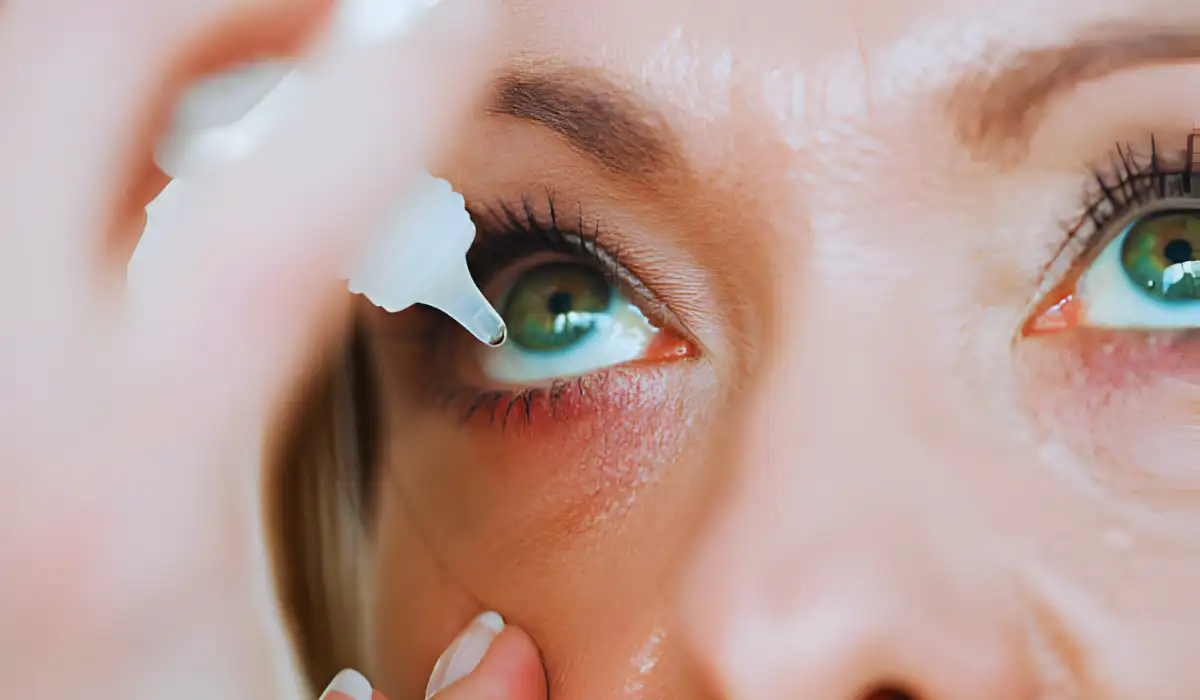If you ever experience headaches and wonder what could be causing them, your eyes may be to blame. Dry eye is a common condition that affects millions of people and can trigger various symptoms, including headaches.
In this article, we’ll explore the connection between dry eyes and headaches and provide tips for managing dry eyes to reduce headache pain.
What are Dry Eyes?

Dry eyes occur when your eyes do not produce enough tears or the tears evaporate too quickly to keep your eyes properly lubricated. As you blink less when staring at screens for long periods, dry eyes have become increasingly prevalent.
Let’s examine the root causes, symptoms, and treatments for dry eyes and answer the question “Can dry eyes cause headaches?”
Dry Eye Symptoms
The most common symptom is a gritty, scratchy, sandy, or burning sensation in the eyes. People describe feeling like they have something in their eye that they cannot wash out.
This irritated feeling may be worse later in the day or by the end of the day when natural tear production tends to slow down. Redness of the eyes or eyelids, stringy mucus around the eyes, eye fatigue, blurred vision, light sensitivity, and stinging or watery eyes are also frequently reported with dry eye.
The symptoms occur because tears are needed to keep the surface of the eyes smooth and lubricated. They wash away dirt and irritants and contain proteins and other nutrients needed for eye health.
When tear quantity or quality is insufficient, friction increases between the eyelids and the surface of the eye during blinking. This leads to inflammation and damage to the cells lining the surface of the eyes.
The nerves in these areas become more exposed, causing eye strain and pain. Insufficient tears also reduce the eye’s ability to focus light properly, resulting in temporarily blurred vision which may come and go throughout the day.
If dry eye is left untreated for a long time, severe inflammation can cause scarring of the eye’s surface tissue and more persistent vision problems. This underscores the importance of recognizing symptoms and seeking treatment early.
Dry Eye Causes
Your eyes require ample moisture to function properly and remain healthy. But various factors can disrupt tear production and lead to chronic dryness,
- Age: Tear production slows as you get older.
- Medications: Antihistamines, birth control, depression meds.
- Environmental factors: Wind, smoke, low humidity.
- Health conditions: Arthritis, diabetes, vitamin deficiencies.
- Screen time: Reduced blinking worsens tear evaporation.
By determining what contributes to your dry eye problem, you can better target proper treatment.
How Dry Eyes Spark Headaches?
If you’re prone to headaches and dry eyes, the two conditions likely fuel one another. Dry eyes can lead to headache pain in a few key ways:
✅ Straining to See
When your eyes lack sufficient lubrication, they must strain to focus visually. This tension can radiate outward to your forehead, temples, and surrounding muscles.
Just like squinting hard leads to an aching head, so can chronically strained dry eyes trying desperately to see clearly. This eye strain sends pain signals to the head that accumulate over time, resulting in headache pressure.
✅ Chemical Release
The act of straining to focus when the eyes feel dry also triggers the release of chemicals around the nerves and blood vessels that service the eyes and head.
Substances like serotonin, histamines, and prostaglandins flare up when eyes strain excessively. These chemicals inflame nerves and dilate blood vessels, leading to enhanced pain signals – especially around the trigeminal nerve connected to headaches.
✅ Trigeminal Nerve
Speaking of the trigeminal nerve, it represents a direct communication pathway between the eyes and brain tied intimately to headaches. When dry eyes grow distressed, they send signals to the brain via the trigeminal nerve.
This not only leads to increased tear production but also adds pressure around the eyes and head. It also signals the brain to initiate headache pain, like sounding an ache alarm.
✅ Stress Reactions
Finally, dealing with the discomfort, annoyance, blurred vision, and complications of chronically dry eyes causes tremendous stress. The frustration of constantly irritated eyes brews tension in the head and body.
Trouble working, reading, or driving due to eye issues leads to muscular strain in the shoulders and neck as well – common trigger points for headache pain. Stress notoriously exacerbates headache frequency and severity across the board.
Treating Dry Eyes to Prevent Headaches
You have several options for relieving dry eyes and curtailing associated headaches. Listing some of them below:
- Apply hot compresses: Stimulates oil glands for natural tears
- Adjust environment: Increase humidity, avoid smoke
- Limit screen time: Reduce tear evaporation
- Take frequent breaks: Rest your eyes when using screens
- Improve sleep hygiene: Allows tear gland recovery
- Consider prescription drops: For severe cases
- Consider punctual plugs: Block tear drainage during sleep
Implementing one or more of these dry eye therapies often minimizes headache frequency and severity by addressing the root trigger eye irritation and strain.
Conclusion
As we’ve explored here, dry eyes represent a sneaky culprit behind many headaches. Insufficient eye lubrication strains your vision system and overworks the nerves and vessels around your eyes and head, resulting in ache-inducing inflammation.
Additionally, dealing with the discomfort, blurred vision, trouble driving or reading, and other issues related to chronically dry eyes causes immense stress – an infamous headache trigger.
References
- Baraness, L., et al. (2021). Acute headache.
https://www.ncbi.nlm.nih.gov/books/NBK554510/ - Ismail, O. M., et al. (2019). Association between dry eye disease and migraine headaches in a large population-based study.
https://jamanetwork.com/journals/jamaophthalmology/article-abstract/2726703

